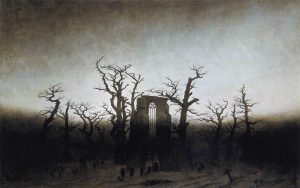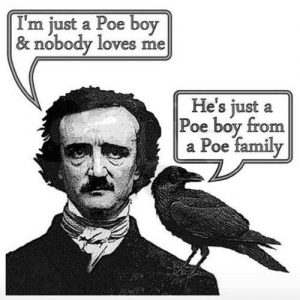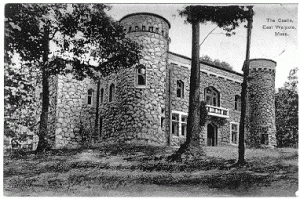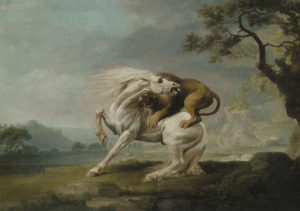Have you ever wished that you could permanently go back to middle school and relive your days of constantly listening to My Chemical Romance or All American Rejects? Do you constantly find yourself saying, “It’s not just a phase” to your loved ones? Does Edgar Allen Poe just really get you? If you’ve answered, “yes” to all three of these questions, then maybe you were destined to belong to the 19th century Gothics.
 ___________________________________________
___________________________________________
This school gained traction in the mid- 18th century, but really became popular in the 19th century, all thanks to a guy called Horace Walpole. Considered the “father of the genre”, he wrote a novel in 1764 titled “The Castle of Otranto”, which first showed people how cool spooky could really be. Walpole is considered one of the first people to begin using some of the themes that underlie most of Gothic fiction, and in extension, Gothic poetry: secret hiding places, the supernatural, and most important to every good piece of Gothic work? Death. After the publication of “The Castle of Otranto”, many were inspired years later by its revolutionary intentions: “The Old English Baron” and “The Monk” were both loosely based off of Walpole’s dark tale. With his success, Walpole ended up renovating a mansion in the Gothic style, which got him a lot of attention and also made people more interested in the architectural aspect of the movement. The house is now called the “Strawberry Hill House”, which is quite contradictory to its origins of darkness.
_____________________________________________
As mentioned above, there are many themes that make up Gothic poetry, but “The Castle of Otranto” exposed the aspects that were popular in novels. Common topics that were present in popular Gothic poetry were: pain, death, unrequited love, the paranormal, horror, dark beauty, and the subjects of the poem often finding themselves in strange locations. So obviously, these are topics that leave readers feeling bubbly and good after reading the poem.
Another aspect of Gothic poetry that made it especially popular was the fact that there was a move towards making readers feel rather than visualize the poem: emotion versus envisioning the poem became a much more popular way to read. The sublime (transcending human thought or emotion) aspect of Gothic poetry is associated with men, while the beautiful (landscape, natural life, etc.) is associated with women, which is interesting because the Gothic movement was quite popular with women more so than men in America. After this poetic school came the Romantic Movement, and it’s easy to see from the poems written by the 19th century Gothics that many Romantic writers gained inspiration from their views of the sublime, nature, and emotion.
We can’t talk about the Gothic school without listing some of the major players that helped shape it into the iconic literary period that it was. One of the most notable poets was Edgar Allan Poe, who revolutionized poetry and other literary works by making them “art for art’s sake”. One of his most well known poems (and one of my favorites) is “The Raven”. An excerpt from the poem follows:
“Deep into that darkness peering, long I stood there wondering, fearing,
Doubting, dreaming dreams no mortal ever dared to dream before;
But the silence was unbroken, and the stillness gave no token,
And the only word there spoken was the whispered word, “Lenore?”
This I whispered, and an echo murmured back the word, “Lenore!”—
Merely this and nothing more.”
In this period, Poe also made his poems pleasing to the ear by incorporating rhythm and internal rhyme, as seen in his poem “The Bell”. This was a unique feature to poems at the time, which were much more focused on being emotionally or aesthetically pleasing, but many Gothic poets used rhyme to convey the mood and meaning more coherently. Poe’s works inspired writers in 19th century France known as “The Symbolists” who in turn, shaped modern literature into what it is today. Poe had many critics who called his work “juvenile” and “artistically debased”, but it’s evident that he simply replied “haters are my motivators” to the comments and then went on to write greater works than any critic could. Unfortunately for Poe, he didn’t have the opportunity to see the long-lasting impacts of his work: he died under mysterious circumstances (there are several conspiracy theories that are very interesting) at the age of 40, but continues to this day to be the go-to man when it comes to teaching 19th century Gothic poetry.
Other famous poets from this time period include John Keats with his “Lamia” and “Isabella: or The Pot of Basil” and Lord Alfred Tennyson, who is known for his famous remark, “Tis better to have loved and lost/ Than never to have loved at all”: this line has a particular resonance with me because I distinctly remember writing it on a desk in middle school when a boy rejected me. I think that the reason that the 19th century Gothic poets resonate so strongly with people today is that the poems (and by extension the poets) are so relatable in their struggles and search for answers to some of life’s basic questions that we all have. Many people are disturbed by the poems when they are presented to them, but often cite the most morbid of passages as their favorite when it comes down to it. There’s something peculiar about the subjects that 19th century Gothic poetry brings up because most of the topics are unexplainable and leave readers feeling empty, but I would say that humans are extremely attracted to the unexplainable and unknown. The poets in the Gothic school of poetry wanted to make their audiences feel emotions that weren’t necessarily popular at the time, but the lasting impressions that they’ve have on the literary world are felt even still today.
______________________________________________
Now that you’ve learned a bit about the Gothics of the 19th century, it’s time for you to write your own poetry based on the general vibe that you’ve gotten from Poe and the knowledge that you’ve gained about this school. Here’s a few guidelines to get you started:
- Begin with an emotion. If you haven’t had your heart broken yet, just think back to the last time you were cut in line waiting for the bathroom at a home game in Sanford. That should conjure up enough emotion to get your creative juices flowing.
- Pick a title. The Gothics in the 19th century were all about meaningful titles because, let’s be real: sometimes people couldn’t even understand what the poem was about without reading the title. One word titles are pretty catchy and easy to remember, and can also really convey how you’re feeling about the emotion of the poem.
- Capitalization. Not such a huge deal. But if you really want to get your point across, don’t capitalize the name of a person, place, or thing.
Now that you have these tools at your fingertips, go out and spread the dark but also strangely relatable words of the 19th century Gothics. It’s a phase you’ll be glad to be stuck in.
- Poet Seers. “19th Century Poets.” Poet Seers. Sri Chinmoy Centre, n.d. Web. 31 Jan. 2017. <http://www.poetseers.org/poets/19th-century-poets/>.
- Poetry Soup. “Famous Gothic Poems.” Poetry, Poets, Poems and Resources. Arczis Web Technologies, INC, 2017. Web. 31 Jan. 2017. <http://www.poetrysoup.com/famous/poems/gothic>.
- Bowen, John. “Gothic Motifs.” The British Library. Dangoor Education, British Library Trust, British Library Patrons, 26 Feb. 2014. Web. 31 Jan. 2017. <https://www.bl.uk/romantics-and-victorians/articles/gothic-motifs>.
- Mullan, John. “The Origins of the Gothic.” The British Library. Dangoor Education, British Library Trust, British Library Patrons, 26 Feb. 2014. Web. 31 Jan. 2017. <https://www.bl.uk/romantics-and-victorians/articles/the-origins-of-the-gothic>.
- Matus, Douglas. “10 Elements of Gothic Literature.” The Pen and The Pad. Leaf Group LTD, 2017. Web. 12 Feb. 2017. <http://penandthepad.com/10-elements-gothic-literature-8104633.html>.
- PF. “Edgar Allan Poe: Bibliography.” Poetry Foundation. Poetry Foundation, 2017. Web. 12 Feb. 2017. <https://www.poetryfoundation.org/poems-and-poets/poets/detail/edgar-allan-poe>.


